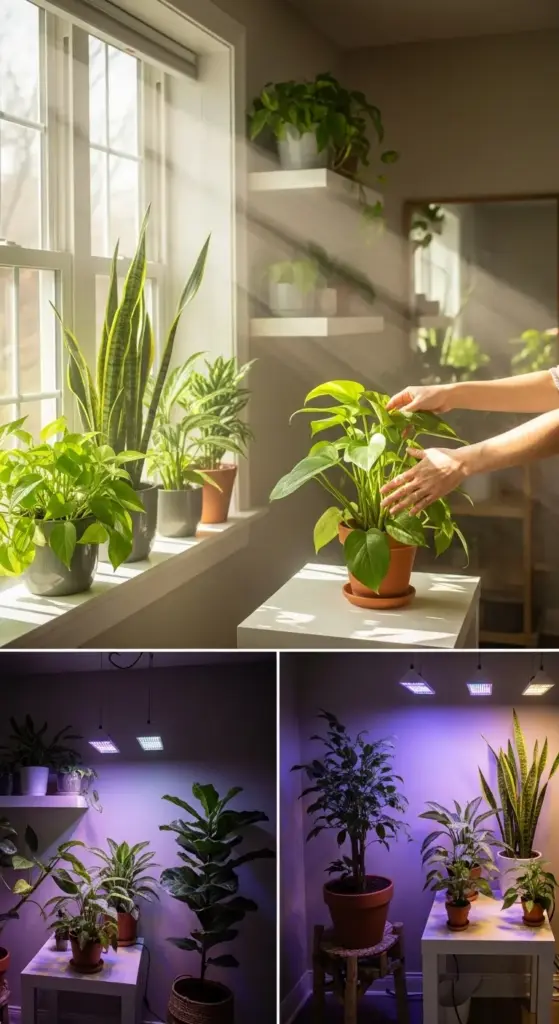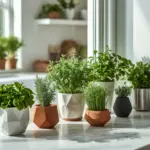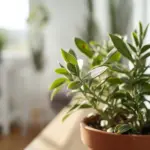4. Optimize Light Conditions Like a Pro

Light was my biggest mystery for the longest time. I thought “bright light” meant “by the window” and called it a day.
Boy, was I wrong. I watched so many plants slowly fade away because I had no clue what they actually needed.
Identifying Different Types of Natural Light in Your Home
Direct sunlight means the sun’s rays hit your plant directly. Think of a south-facing window at noon – that’s intense, baby-burning-your-retinas kind of light.
Most houseplants hate direct sun. I learned this after my beautiful pothos got crispy brown patches from sitting in a sunny spot.
Bright indirect light is the sweet spot for most plants. It’s like sitting under a beach umbrella – bright but not harsh.
North-facing windows give you consistent, gentle light all day. Perfect for low-light plants like snake plants and ZZ plants.
Medium light is what you get a few feet back from a bright window. Most of my plants live in this zone and they’re happy campers.
Low light doesn’t mean no light – it’s still bright enough to read a book comfortably. Dark corners where you need a lamp during the day? That’s too dark for most plants.
I used to think my bathroom had “bright light” because it felt sunny. Turns out frosted windows filter out way more light than I realized!
Supplementing with Grow Lights for Darker Spaces
LED grow lights changed my plant game completely. I can finally grow things in my windowless office!
Full spectrum lights mimic natural sunlight and work for pretty much everything. I bought a $40 one on Amazon and it’s kept my plants thriving through two winters.
Purple grow lights look weird but plants love them. Just don’t expect to use that room for anything else – it’s like living in a nightclub.
Timer-controlled lights are essential. Plants need darkness too! I run mine for 12-14 hours during winter months.
I made the mistake of buying cheap grow lights first. They barely helped and died within six months. Invest in quality from the start.
Distance matters with grow lights. Too close and you’ll burn leaves, too far and they won’t help. I keep mine 12-18 inches away from most plants.
Rotating Plants for Even Growth
This seems obvious now, but I used to wonder why all my plants grew lopsided! Plants lean toward light – it’s called phototropism.
Quarter turns weekly keep growth even. I do it every Sunday when I check for watering needs.
Hanging plants need rotation too. My spider plant looked like it was trying to escape its pot until I started turning it regularly.
Larger plants are harder to rotate, so I move them to different spots seasonally instead.
I learned this lesson the hard way with a fiddle leaf fig that grew completely sideways reaching for my window. Took months of patient rotating to straighten it out.
Seasonal Light Changes and Plant Placement
Winter light is so much weaker than summer light. What worked in July definitely won’t cut it in January.
I move plants closer to windows in winter and farther away in summer. It’s like a seasonal plant shuffle in my apartment.
Deciduous trees outside your windows change everything. My east window goes from bright to medium light when the maple tree leafs out in spring.
Summer sun can be brutal. I had to move my calathea away from the window when it started getting leaf burn in July.
Daylight hours shrink dramatically in winter. Plants that thrived on natural light alone need grow light supplements during the dark months.
Creative Solutions for Windowless Rooms
Mirrors can bounce light into darker corners. I put a large mirror opposite my brightest window and it definitely helps nearby plants.
Light-colored walls reflect more light than dark ones. Painting one wall white made a noticeable difference in my plant room.
Glass doors between rooms let light travel further into your home. I keep my bedroom door open during the day so hallway plants get some benefit.
Skylights are amazing if you have them. The light comes from above just like in nature.
I turned my dark hallway into a plant corridor using a series of grow light strips mounted under floating shelves. Looks modern and keeps plants happy.
Light tubes or solar tubes can bring natural light into interior spaces. Expensive to install but game-changing for serious plant parents.
Light Requirements for Popular Houseplants
Snake plants tolerate almost anything but prefer bright indirect light. Mine lives in a corner that gets maybe 4 hours of indirect sun daily.
Pothos are super adaptable. They’ll survive in low light but grow much faster in brighter spots.
Fiddle leaf figs are drama queens about light. They want bright, consistent indirect light and will drop leaves if you move them.
Succulents need the brightest light you can give them. South-facing windows are perfect, or supplement with grow lights.
Peace lilies actually prefer medium to low light. Too much sun and their leaves get pale and sad-looking.
Monstera deliciosa likes bright indirect light but can handle medium light. Just don’t expect those gorgeous split leaves in darker conditions.
ZZ plants are the champions of low light. I have one thriving in a spot that gets maybe 2 hours of indirect light daily.
Rubber trees prefer bright indirect light but adapt to medium light pretty well. Just expect slower growth in dimmer spots.
Ready to feed your perfectly lit plants for explosive growth? The next section covers plant nutrition – including the fertilizer mistake that nearly killed my entire collection and the simple feeding schedule that transformed my plants from surviving to absolutely thriving. Click “next” to unlock the secrets of plant nutrition!









GIPHY App Key not set. Please check settings